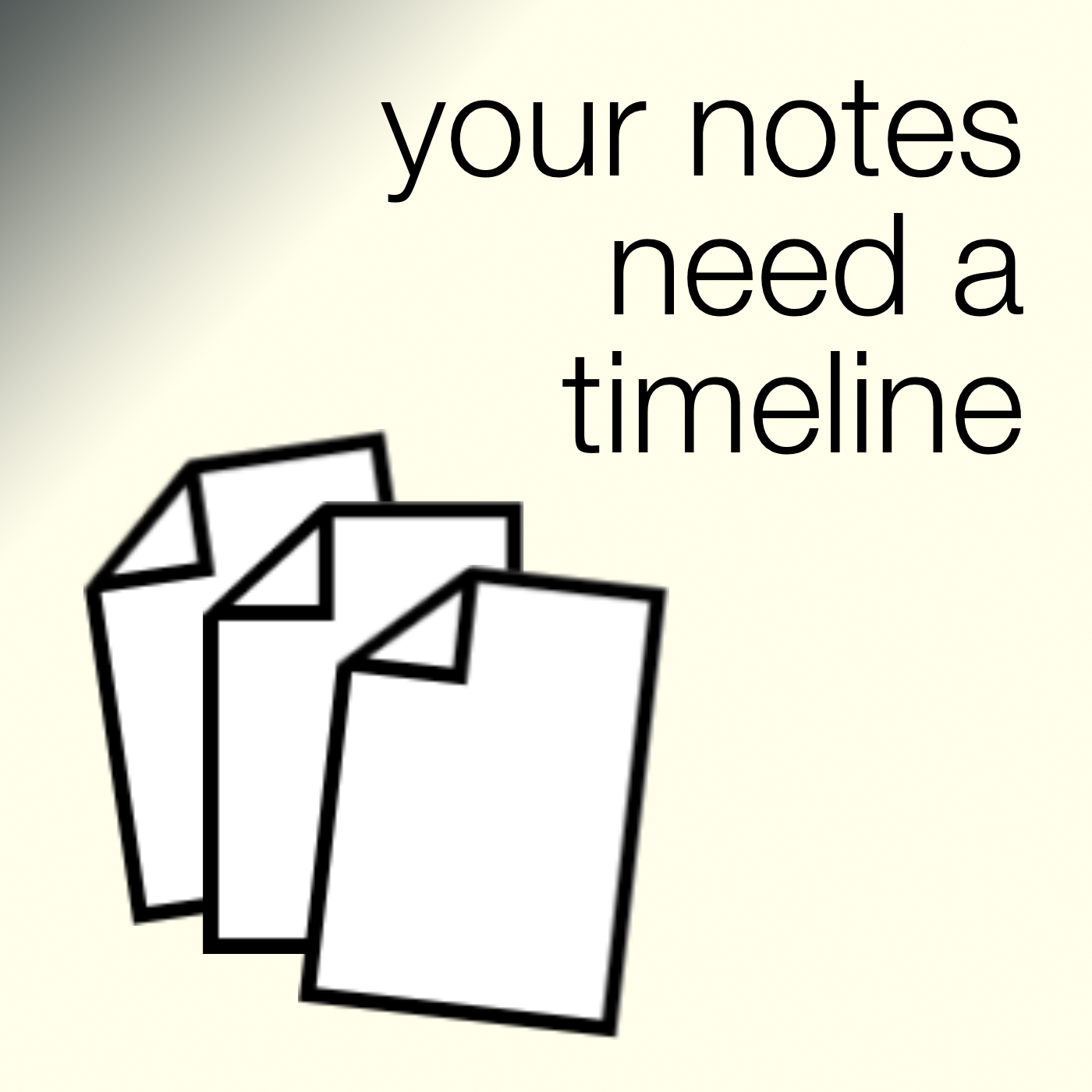Evernote
- Your Data is Yours
- Your Data is Protected
- Your Data is Portable
- BookFusion
- How we’re responding to The New York Times’ data demands in order to protect user privacy
- NYT vs. OpenAI
- Na prática, o plano gratuito do Evernote acabou
- Quantas pessoas usam o Obsidian?
- Home
- Shortcuts
- Note
- Notebooks
- 2024–09–19 Paris Itinerary
- 2024–09–19 Flight OPO-PAR-OPO
I'm not taking my chances anymore. From Apple II to Obsidian—My digital memories now stay local.
I can see how appealing something like the Pixel Journal can be to many people. It’s super convenient and will probably be connected to every single Google service—even Gemini—at some point. But just like the iPhone counterpart, in my opinion, it’s yet another way to imprison users in their platforms.
Pixel Journal now available for the Pixel 8 and 9 series. 9to5Google
I’ve lost just about all my digital notes from before 2008 because of how unreliable backup solutions were and the many times I switched to a different system (Apple II, DOS, Windows, and Mac) and software (WordStar, Word, etc.).
Even many of my posts online, which started as static HTML and then moved to proprietary platforms, were lost several times along the way. Thankfully, I could recover some of them by digging through the Internet Archive, but that’s far from ideal.
In 2008 I started using Evernote, which from the very beginning had something called the 3 Laws Of Data Protection:
The “Portable” part is technically true, and I could move all my notes to Obsidian last year, but it’s not as straightforward as they want you to believe. Anyway, I learned my lesson with the process and decided that my precious memories need better care.
I’m not saying Obsidian is for everyone or that it is the best solution, but having my memories in Markdown format and locally saved first gives me an immense peace of mind. I’m not taking my chances anymore; even my blog posts start as Markdown notes and are locally preserved in that format.
I’ve been doing so many experiments with #Obsidian Bases, but one of the first things I did was to make a list of all my notes to try to mimic the way I used the #Evernote list of notes.
I’m pretty sure some of you will ask me why I blurred tags and other information that doesn’t seem that private. Well, they are. For example, I have my car license plate as a tag, and because it starts with a number, it’s the first one that pops up in the list. Some of the Bases views have the names of places, like where my new home will be. The People property has the names of family members, clients, etc. Anyway, there’s a reason for everything I blurred.
As for having a separate account for the videos, I do have one and use it for most recordings. However, every once in a while I like to share my real account because it has so many details I tailored over the years, and it’s impossible to keep a 100% accurate copy of that in a second account.
Hoje tive a certeza de que estou 100% adaptado ao #Obsidian. Muitos de vocês têm me recomendado o plugin Notebook Navigator, que cria uma interface de navegação parecida com a do #Evernote. Instalei há pouco para fazer alguns testes e imediatamente me senti completamente fora do meu habitat natural.
O plugin parece muito interessante e pretendo experimentar as funcionalidades em um dos mus cofres para testes. Quem sabe até produzo um vídeo. Mas não durou nem mesmo alguns segundos no meu cofre principal 🫣. Desinstalei pouco dempo depois de começar a navegar um pelas pastas.
Como o Obsidian viabilizou o projeto Home das Cavernas Digital.
O termo ‘Homem das Cavernas Digital’ é uma invenção recente, mas a ideia de ter todo meu conteúdo concentrado em um local que esteja sob meu controle é muito antiga, vem da época em que comecei a usar o Evernote. Aliás, antes disso eu já vinha tentando criar uma estrutura de pastas que eu pudesse usar no meu Palm e no meu computador ao mesmo tempo.
Lembro que quando os novos modelos de Palm começaram a vir com leitores de cartão de memória, passei a andar com um leitor de cartões USB no meu chaveiro. Com todos os arquivos em um mesmo local, era possível conectar o cartão ao meu computador do trabalho para ler os documentos .doc e .xls, que no Palm eu conseguia abrir usando o app Documents To Go
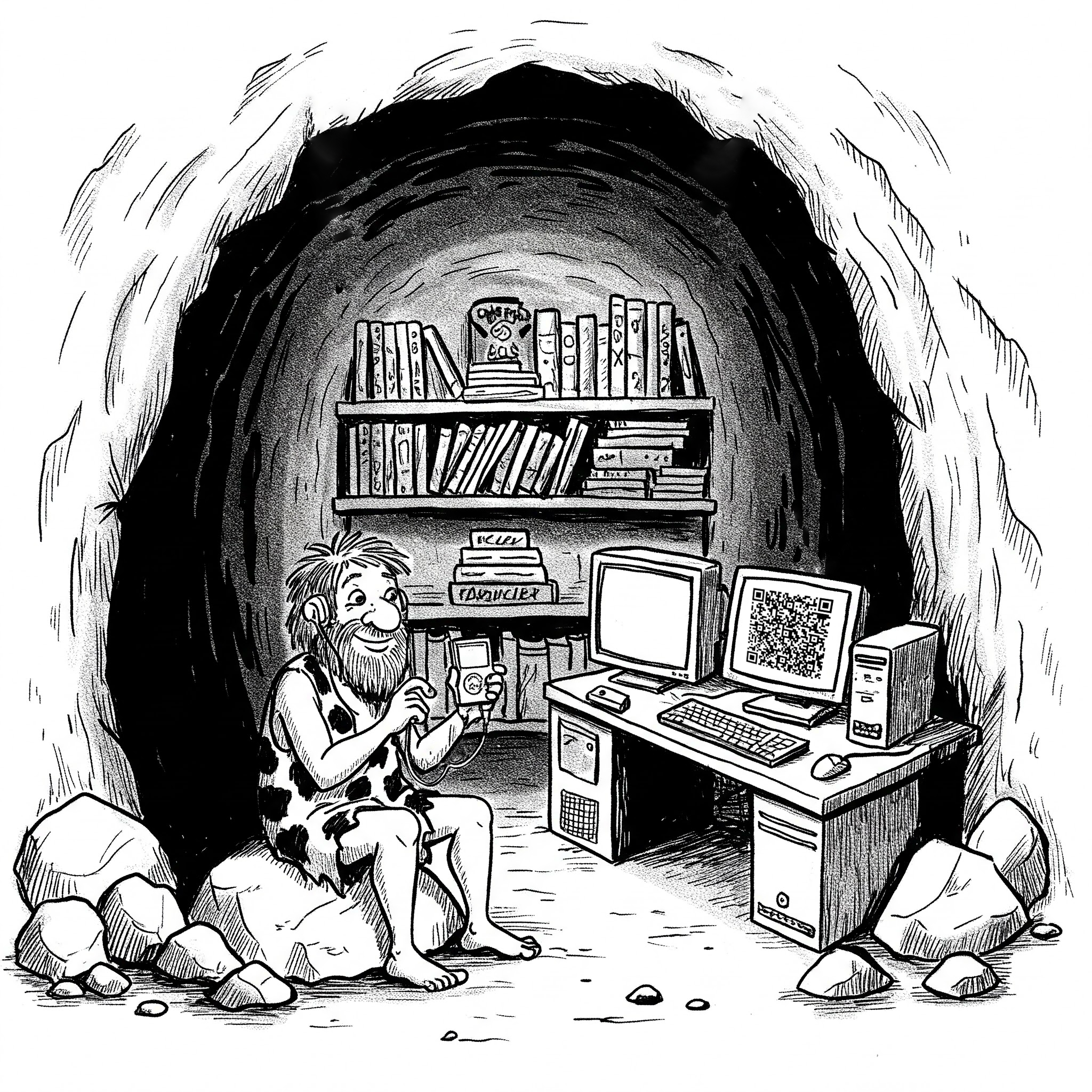
De volta o presente, a contribuição do Obsidian, foi simplificar o projeto. Como o app é basicamente um conjunto de pastas do meu computador, se eu colocar tudo naquelas pastas, será muito mais fácil sincronizar, fazer backups, etc.
Finalmente, uma das coisas que o Obsidian me permite fazer é interligar todo esse conteúdo que produzo. Das minhas anotações pessoais a tudo que publico online.
Links
Há uma pequena lista de coisas que nunca consegui fazer no #Evernote e que são relativamente simples no #Obsidian. Dentre elas, transformar parte das minhas notas em posts.
Houve algumas ferramentas, como o Postashio, que tentaram fazer essa mágica acontecer lá no elefante, mas nenhuma deles jamais funcionou tão bem quanto as opções que testei até o momento no Obsidian.
Esse texto, por exemplo, foi escrito no meu Android em uma nota do Obsidian e graças ao plugin Micro.publish ela foi convertida em um post assim que terminei de escrever.
Nenhuma complicação ou dificuldade. Apenas um simples comando e você está lendo algo que escrevi usando meu telefone e sentado na minha varanda depois de voltar de uma corrida 😉
Sim, é possível fazer o mesmo usando um app de qualquer rede social. Mas isto aqui é o meu blog, com as minhas regras e com uma cópia dos meus posts arquivados no meu computador.
Por que migrei para o #Obsidian?
O processo de migração do Evernote para o Obsidian não aconteceu de uma só vez. Foram vários detalhes que me levaram a esta decisão. Sendo o mais importante deles o controle sobre meus arquivos.
Tópicos Relacionados
Inscreva-se no Podcast, que, a propósito, continua em estágio experimental.
Careful. This can mess up your Obsidian Vault settings.
What you are about to read is a real story that happened to one of my clients recently.
Let me start with some context. This is a person who was an Evernote user and who recently switched to Obsidian. He contacted me to help him with his company’s workflow and also with his personal life organization.
We started with the personal life part, and as I was showing him how to set up the Timeline System, I was also sharing some Obsidian good practices. There was a lot to do, and that’s why I was gradually introducing him to the system and adding plugins as he needed them. All that to say that it was a bit frustrating for him to see everything going away so easily.
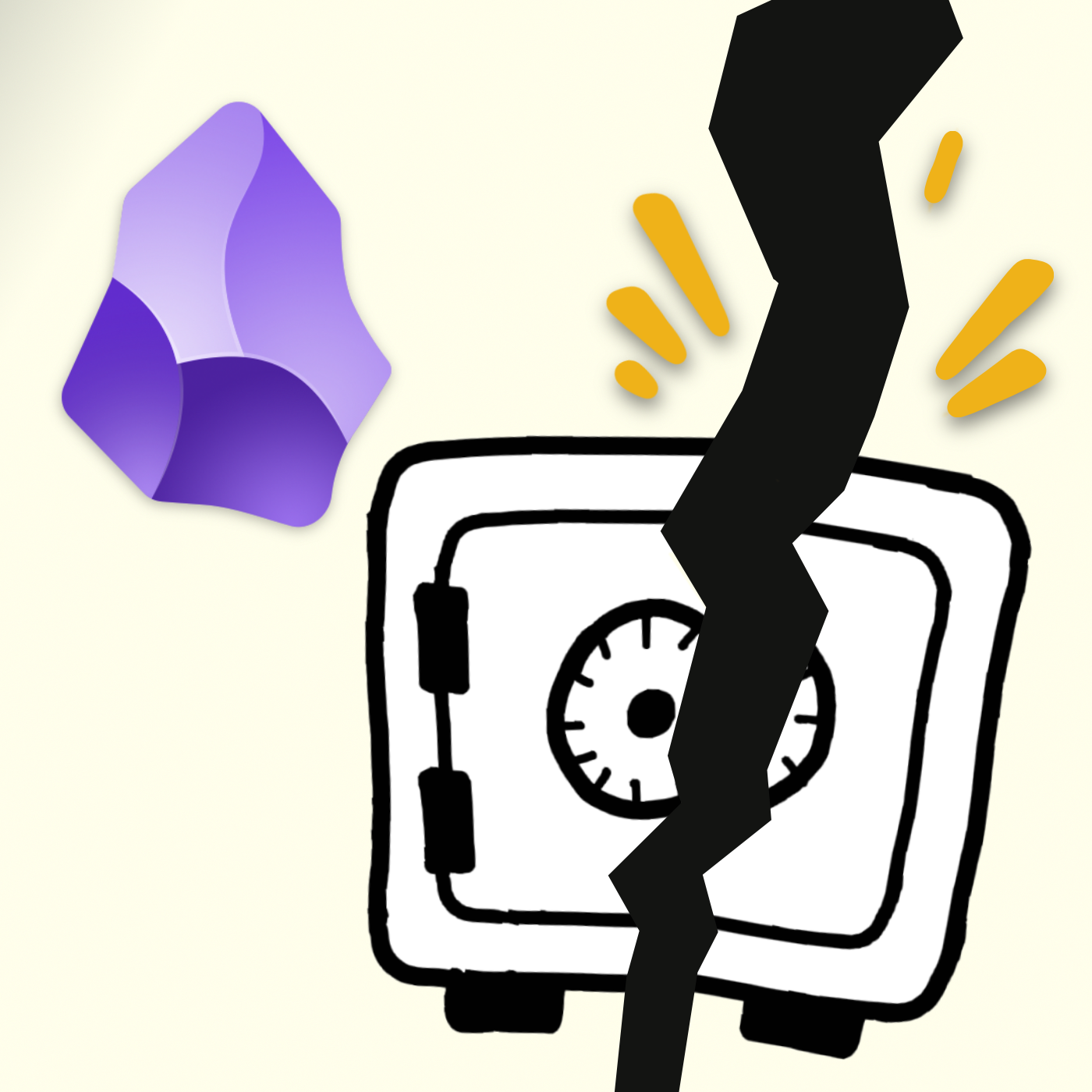
When he shared his screen, the accent color he had already changed was back to the default purple, all the plugins were gone, and there were other small problems here and there. I could clearly see that something had happened to the Obsidian settings folder, but when I asked if he had done something to it, he told me he didn’t even know about it. Just in case, I decided
Refining my note-taking workflow—lessons from Evernote for Obsidian.
As someone who believes that serious note-taking needs a solid system, I’ve frequently encountered a challenge: effectively managing my ever-growing collection of notes.
Dynamically switching between multiple views of the same information is a strategy I used a lot in the past. However, I lost that when I moved to Obsidian, as I find its handling of lists of notes less intuitive than Evernote’s elegant approach.
I can’t think of any note-taking app that handles note lists quite like Evernote. Its “All Notes” list is essentially a dynamic filter displaying all your notes. If you’re an Evernote user, you’ve likely noticed that the list automatically refines as you click on notebooks, tags, and so on, transforming to show exactly what you need. This brilliant method of listing notes is something I truly miss in Obsidian.
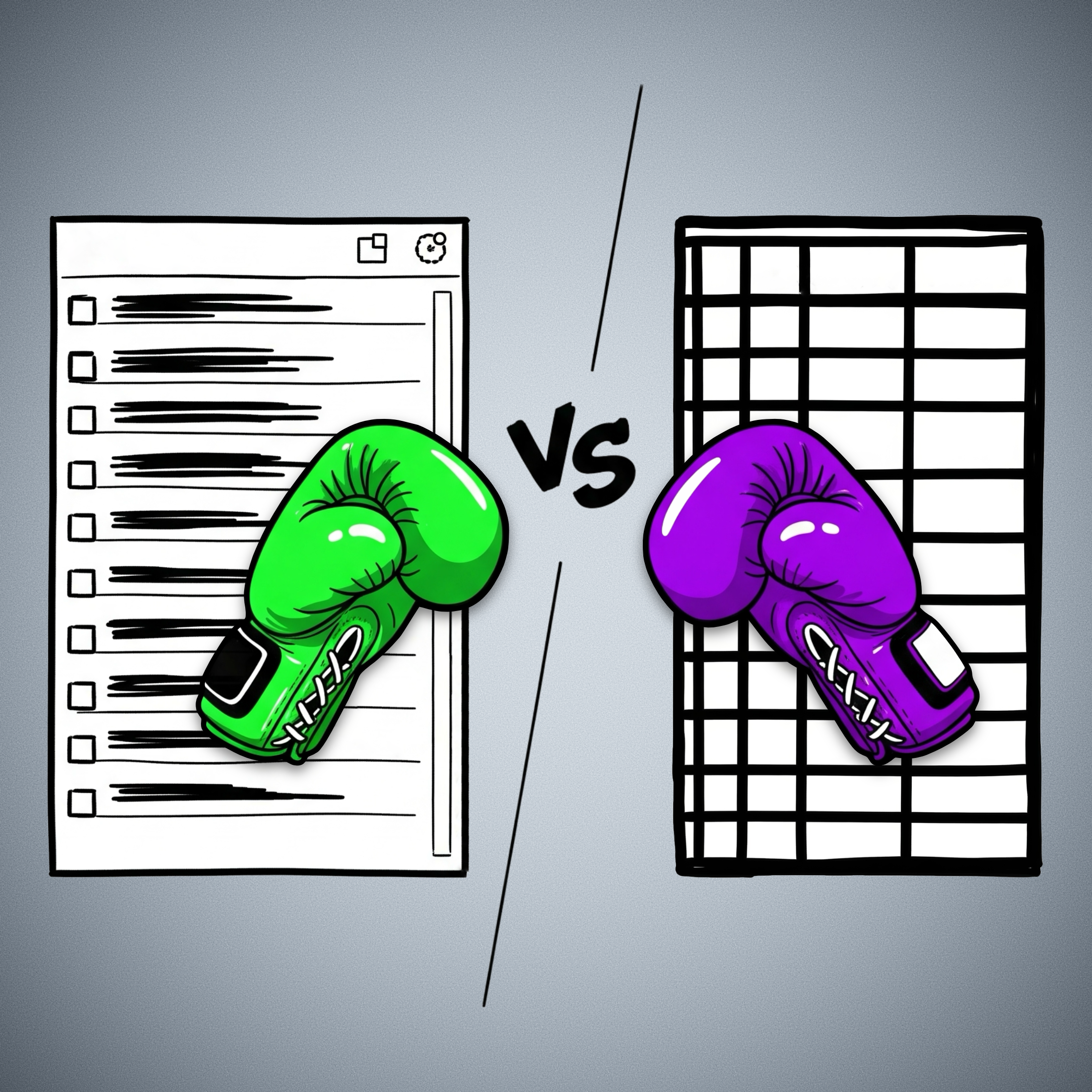
When you select a notebook, tag, stack, etc. in Evernote, the items in the list are filtered to show only notes within that group. So much so that you can easily replicate this filtering using the advanced search operators.
For example, typing tag:tag-a in the search box yields the same list as clicking on the tag-a tag. Evernote’s AI-powered search functions similarly; the displayed items adjust based on the elements the AI selects to create the filter.
In Obsidian, however, filtering notes by a tag or using the search box will also list the items, but I’m limited in what I can do with the results. While I can clearly see the list, there’s no way to select all items and, for instance, add a tag to them or move that group of notes to a different folder.
In Evernote, this is not only possible but incredibly easy. You just select and move them to another notebook. While a limit on the number of selectable notes exists now, it wasn’t there before Evernote 10.
This clever way of displaying notes does come with technical challenges, though. For example, I believe the current selection limit was imposed because, in the past, moving long lists often led to significant conflicts.
Because there’s no easy way to filter notes in dynamic lists like in Evernote, I opted for subfolders within my Timeline System in Obsidian. But by doing so, I sacrifice a true timeline of my life’s events, as each type of information is located in a separate subfolder.
I haven’t tested Bases yet, but judging by the official documentation, it appears there’s no limit to the size of lists a Bases file can handle. If true, I’ll finally be able to build a real timeline by creating a single Timeline.base file that lists everything from the subfolders within my Timeline folder. Not only that, but I’ll have access to various dynamic filters within that Timeline.base file.
While I’d prefer not to, if the number of files proves too large for the new Bases feature to handle, I can always split it into yearly files: 2025.bases, 2024.bases, 2023.bases, and so on.
It will not be a perfect replacement for Evernote’s list of notes, as I will not be able to select multiple notes to add tags, move them elsewhere, and any other bulk action. But I’ll at least, have a real timeline and multiple possible filters.
The Bases feature is still in beta, and online discussions suggest the final public version will take some time. Meanwhile, I can ensure my Timeline notes have all their properties populated with the proper data, allowing my Timeline.base to beautifully simulate the visual effect of multiple views of the same list, just as I was accustomed to in Evernote.
Ultimately, my goal with the Timeline System is to create a note-taking system that truly adapts to how we think and behave, allowing us to interact with all the information we deal with in a fluid, intuitive way. Bases seems to be a promising step in that direction regarding using the Timeline System in Obsidian.
What about you? Any plans for the new Bases feature?
Obsidian is great, but learning is inherently hard
If you are looking into switching to Obsidian, maybe my journey can help you.
The very first video about Obsidian was published on my YouTube channel on March 14, 2023. What some of you may not know is that I had been using it for longer than that to help clients here and there.
However, that amount of time is nothing when compared to the muscle memory I have developed from using Evernote for every little thing in my life for 16 years. The problem with the new is that it is always unwelcoming. It’s not only the different way of doing things; it’s also the constant uncertainty about doing anything. And at that point, Obsidian was not only new to me, but there’s also the sheer number of settings and plugins making it feel so overwhelming.
To make matters worse, I decided to bring my YouTube audience along with me on that new journey. For a long time, I have had the idea of creating a vlog-style productivity series on my channel that would show how I organize life and work. I thought that learning Obsidian would be a great opportunity to try that, but it ended up creating unnecessary confusion, as it is challenging to film myself figuring out things happening in real time.
Back to my point. After so many trials and errors, I’m now much more comfortable with how Obsidian works. Some of the setups I came up with, like the homepage demonstrated in the video below, are now running for a considerable amount of time and working so well. Furthermore, my Timeline System has matured to the point where it allows me to seamlessly navigate my daily activities.
Don’t tell anyone, but because of all of that, I feel like recording many of my past videos again. Anyway, you are not here for this. Let’s go through my tips for switching to a new app.
Before that, a disclaimer is needed, right? The following is how I did things. It’s also based on the strategy I use to help my clients, but it may not be suitable for you. So think of the suggestions below as just that, suggestions.
From Evernote to Obsidian
First, I didn’t abandon Evernote. I knew how things worked there, which mad it my safe haven during the transition period.
With that in mind, the first actual homework was to learn the basics about the mysterious Obsidian. Because of my clients, I had already done part of that before. But now I needed to move a step further and see how things would work in real life. To accomplish that, I created the first of many local vaults on my Mac to work as a sandbox.
Once that was done, I copied, I repeat, copied, not moved, parts of my notes. In some ways, Obsidian is so similar to Evernote, but in others, like how files are stored, it’s an entirely different approach. However, it works in such a way that you can have as many vaults as you wish and easily delete the ones that didn’t work. As long as you are coping your files, you can consider the multiple vaults to be a process of prototyping and iterating.
Like I mentioned at the beginning of the article, there’s a universe of settings and plugins. I suggest avowing all plugins as you are getting to know your way around. As for the settings, try to look for the answers as you need them. For example, when you feel like you have to learn how to format text, go look for tutorials on how to do that.
As you get used to it, move some more parts of your system, but I would still think of what you are doing on the new app as in experimental mode. It will take a while for you to get used to the numerous new things that are still making you uneasy.
If you followed my progress on YouTube, you know that I was constantly changing my setup and being frustrated by all the new ways of doing things. And let’s not forget that I was doing all the above while still using Evernote. So much so that at a certain point, I had a good portion of my activities being managed with the help of both apps, and that was driving me crazy.
To make things even more miserable, Evernote decided to redesign its mobile app. Now, on top of learning a new system, I had to adapt to a new way of doing things on the app I was so familiar with.
It was a lot, but it was worth it. It felt like a final partnership with my old friend, Evernote. The new design and new ways to do things helped me eventually find a way to implement the Timeline System that had been brewing in my head for so many years. Yes, the Timeline System I use in Obsidian and in the Supernote came to be because of my struggles with Evernote.
With that settled, the next step was to replicate the system in Obsidian and start moving all my files. But I did it one notebook at a time. I would export an Evernote notebook, import it to Obsidian, organize all the mess, and, just as a last resort, keep the exported notebook as a backup. In case you are wondering, yes, I still have them in a backup drive.
Plugins
But we are not done just yet. As I have already mentioned several times, Obsidian is full of settings and plugins. My strategy here is the same as at the beginning of this process. Whenever I need something that Obsidian cannot do, I start looking for a plugin.
I try to stick with the ones that do one of a few things, but every so often that’s not possible. For example, the Tasks plugin is too much for my needs, but I couldn’t find a lighter alternative that would work for me. Templater and all its features is one that I’m avoiding, as the Auto Template Trigger does almost everything I require. But when it comes to having fun, it looks like that rule doesn’t apply. I love using and tweaking every detail possible on the Map plugin.
Which brings us to one of the reasons I switched to Obsidian. Evernote has been on a downward trend of removing features since version 10 was released. I thought for a moment that Bending Spoons was going to bring old features back, but they kept removing them.
Guess what, many of the removed features I used to love in Evernote exist on Obsidian as a setting or are available as a plugin. And in most cases, these are better variations of what existed on Evernote. And that makes me so full of joy! It’s like being in a parallel universe, where Evernote evolved to what Obsidian is today. Back to reality, I’m definitely happy. So happy!
In summary, what I’m trying to say is first, have a safe haven. Second, take your time. Really, take your time. This will be a long project. Third, you already have a lot on your plate, don’t create more problems for yourself. Go look for settings and plugins only when you genuinely need to fulfill a specific requirement.
Evernote's new PDF viewer is beautiful, but it's like a new skin over old problems
Perhaps it is time to remove Evernote from the toolbox of options I suggest to my clients.
Let’s start with the toolbar, which was beautifully redone, but as far as I can tell, there’s nothing new there. Actually, I’m missing an important detail — that, to be honest, I’m not sure if existed before or not.
Where is the undo button?

Using cmd+z (Mac) works fine, so the function exists. If they forgot about it, I hope they bring it back as soon as possible. If it wasn’t there, it seems to me that this was a missed opportunity to add it.
Meanwhile, the options Select all annotations and Clear annotations in the dropdown menu help circumvent that. But keep in mind that all means only those on the page being displayed.
By the way, I think the dropdown menu is a pleasing addition. The quick access to the Fit to page width option is a great start to making this a viable PDF reader. Which brings us to a problem so many of you have been complaining about to me over so many years.
It’s a view, not a reader
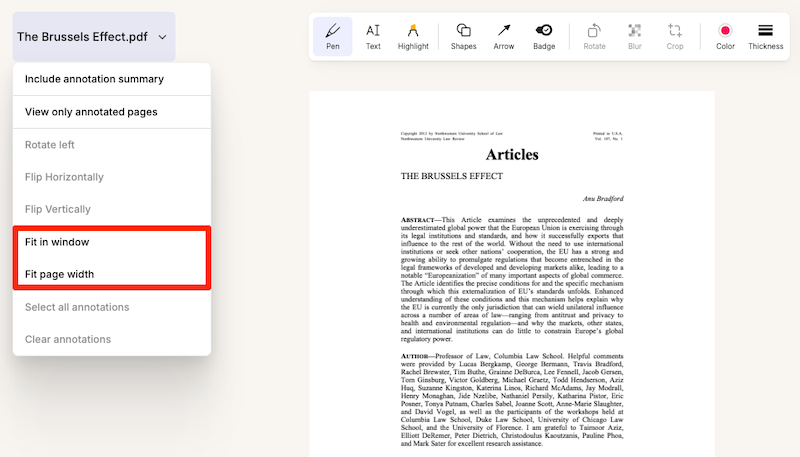
If the tool doesn’t remember the page we were on when we closed the PDF, it’s just a viewer, not a reader. And that is only one of the details that has been preventing me from using Evernote to read long documents. When reading and taking notes, I was used to relying on a PDF reader instead, but that came with an inconvenience. Evernote couldn’t be the place to store the PDFs.
It’s true that one can use the ‘open with’ option to open the PDF using another reader. But as far as I know, this is only available when using the desktop client, and we’ve been living in a mobile-first world for a long time now.
When the Files feature was added, I presumed that the final goal was to give us direct access to the files we keep in Evernote, but that never happened. Actually, even after all the time that has passed since it was released, it is still a half-backed feature causing more confusion than anything else.
Another step towards Obsidian
A long time ago, I moved all my PDFs to Google-Drive , but that ended up creating all sorts of inconveniences. Ironically, the idea was inspired by how Obsidian stores our files. Fast-forward to today, I gave up on the workarounds. I’m now reading my PDFs using whatever app I feel like, and, at the same time, the files are kept organized in Obsidian. Having the PDFs visible in the computer file structure creates a lot of freedom to do many things.
Bugs, bugs, and more bugs
Back to Evernote. Another nice touch in the dropdown menu is the Include annotation summary option, which in the past used to be a buried checkbook that many people didn’t even know was there.
This is a nice feature, which adds new pages to the beginning of the PDF, including all the annotations. Unfortunately, something is now broken. As illustrated by the video below, many of the PDFs I tried, created a messed up page. Furthermore, the summary now seams to only be visible in the note view. In the past, these notes were also visible in the PDF view mode.
There’s another inconvenience that makes Evernote challenging to use as a PDF reader. If you watched the video above, there’s an annoying flicker happening every time a page is turned. And I’m pretty sure this was not there before. On that same note, if we use the thumbnail to jump to a specific point in the document, that page opens in the middle of the text. And that’s precisely where starting at the top of the page would be a much better option.
I would like to end this post with a more optimistic view for the future of this feature and Evernote in general, but I’m not entirely convinced that that’s possible. The new Files feature is not the only one half-backed. Many of the new features are simply not useful as they are, and more often than not, they arrive with new bugs.
Frankly, I’m tired of trying to tell Evernote’s team that the ‘moving fast and breaking things’ strategy should not apply to something so important as our personal notes. This will deeply sadden me, but maybe it is also time to take Evernote out of the toolbox of options I recommend to my clients.
Bending Spoons was the best thing to ever happen to Evernote
The more I learn about how Evernote was operating before Bending Spoons bought it, the more I love how well it’s been taken care of now.
Although I began using Evernote in 2008, it was only in 2012, when I joined the Ambassadors Program, that I found myself gaining access to some inside information. But just like what happens today as an Evernote Expert, there was never full access to all the details, strategies, or plans for the future. For those, I’ve always done my homework, consuming every bit of public information and connecting the dots myself.
Things got slightly more complicated when they were acquired by a company I had never heard of before. That meant starting from scratch to learn all about Bending Spoons.
Like in the past, I found myself reading, watching, and listening to everything I could find related to that unknown company. And I mean anything. Even if it is about products unrelated to Evernote, like the recently acquired StreamYard.
As a non-developer, I don’t follow the Pragmatic Engineer Podcast because I wouldn’t be able to understand the majority of the conversations. But when I noticed a trio of executives from Bending Spoons in the same episode, I had to watch it and do whatever it took to understand what they were talking about.
Fortunately, the episode was not as challenging to follow as I was expecting. Everything that Luca Ferrari (cofounder and CEO) and Federico Simionato (Evernote product lead) said, I understood. But the many technical details explained by Francesco Mancone (CTO) meant pausing the podcast every few seconds to go learn about new terminology.
I had to watch it a few times because of his technical explanations. The first time was on a plane when I was going on vacation. Without the internet, there was no way to research anything online, but the one-hour-long episode gave me a good sense of how dense the material was. Back at my office, I could delve into it and “translate” all the technical jargon. The video below has my take on it, but that’s not the only thing I talked about.
I like to understand the reasons behind anything I’m learning, so it was incredibly helpful to listen to the cofounder go over the history of Bending Spoons. Not only that, but as I explained in the video above, the company operates in an unusual but fascinating way.
And there’s more. Being a fan of a lot of the Agile principles, I couldn’t help but notice some of them in Luca’s words. It would be wonderful to have him on my YouTube channel some day for a conversation about Bending Spoons.
Although I’m frequently in touch with Federico, there’s always something here and there that I’m learning from his appearances on podcasts. This time, it was the standalone app that will be released to showcase how great Evernote’s transcription feature is.
I have extensive knowledge about Evernote’s history, but it’s quite uncommon to get access to inside information. This is where listening to Francesco was instrumental in bridging certain gaps. When I contrasted the information he shared to all the moments I’m familiar with, I could realize the impressive amount of work the team is doing.
He was the one who helped me understand how much work is in progress to bring Evernote’s technical capabilities to the level of modern apps. And I’m not talking about new features; it’s about rebuilding almost everything under the hood. In other words, things that people don’t see, but that are instrumental to a seamless experience.
Now that I have a more in-depth understanding of how Bending Spoons operates and what is actually happening to my beloved app, I’m more confident than ever that Evernote is in great hands.
The problem with Evernote’s AI, is Evernote
Navigating Evernote’s AI Journey: Balancing Privacy and Functionality.
Although Evernote has gradually evolved into a more collaborative space, it has been a place for personal note-taking since its inception. Furthermore, the company has consistently emphasized its privacy-first approach throughout the years.
If we compare that to how AI normally works, I believe it is a bit difficult to create an environment that will make both pro and against AI users happy and comfortable with the app experience.

An immersive AI experience like we see on Voicenotes would mean giving the Large Language Model access to all the notes and everything in our Evernote. Some people would never accept something like this, but that is precisely how to create an outstanding experience of fully interacting with our notes and all the memories and knowledge we have saved over the years.
I appreciate the way Bending Spoons approaches this challenge by always asking permission when the topic is AI, but that means there is no complete or fully immersive experience going on. For example, as I explain in the video below, AI-Powered Search sends just a handful of notes to the LLM.
Perhaps the solution is to give users choices. Option number one would be the current one, with a pop-up constantly reminding us that part of the information is being sent to the AI model. Option two would be to add a setting that would allow us to select which notebooks can be fully scanned by AI. The other ones would be susceptible to the current opt-in system.
I believe this approach would also be useful to make the proposed chatting with Evernote to be something with a higher degree of quality in the answers.
And since I’m playing with the idea of options, why not a ‘turn off all AI’ toggle? This would disable all current and future AI features, giving skeptical users the confidence that they would never accidentally send notes to the AI Model.
What about you? Which group are you part of? Privacy first or AI superpowers?
Strip down Evernote and go back to basics to focus on notes.
Tired of Evernote’s clutter? Too many features overwhelming you? This is how you can strip it down to a pure note-taking app.
Those of you who have already watched the video at the end of this article, know how happy I was when I first tried that new Sidebar Configuration feature. I was both nostalgic and overjoyed to see my decade-old companion working as a note-taking app again.
If that’s also your goal, here are some tips to convert Evernote into a plain, simple#note-taking app. But first, make sure you have the correct version. The settings below are only available on version 10.107.3 or later.
Removing Distractions
Click on your name in the top-left corner of the screen, open the Settings menu and go to the Sidebar tab.
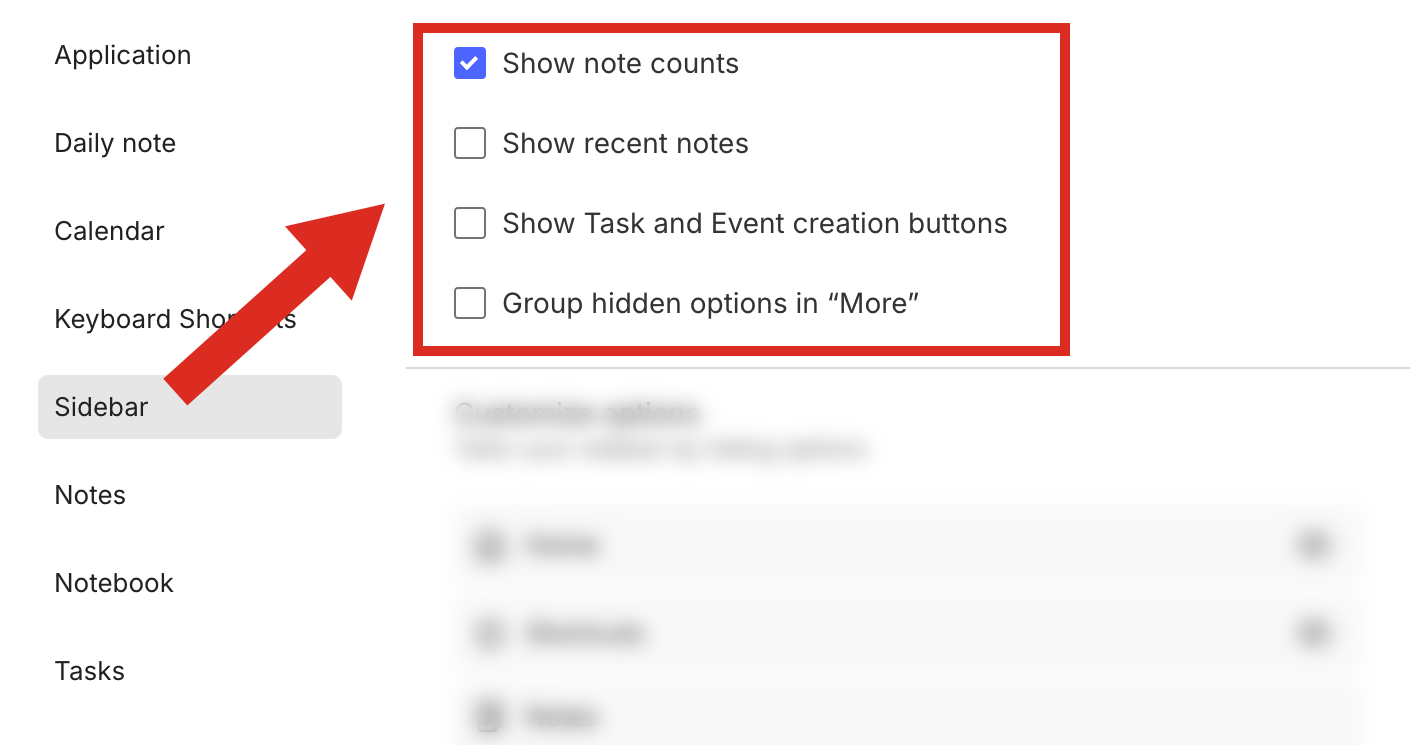
Uncheck the Show Task and Event Creation buttons option to remove the big, super-distracting purple and red buttons from below the Note button. However, as a reminder—or tip—they are still accessible by clicking on the three dots.
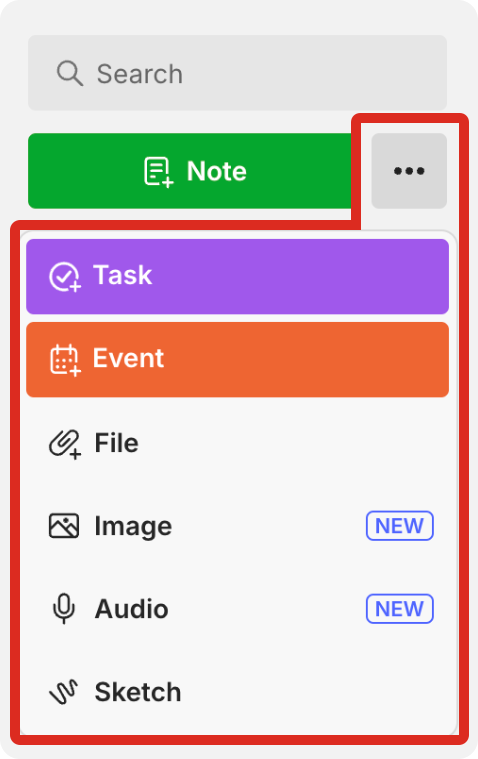
The Show note counts is an important element in my Timeline System and I kept it checked. As for Show recent notes, I prefer them on the Home page because I can see the thumbnails. As a side note, both of these settings have always existed.
We’ll soon get back to the last option on that list. For now, scroll down to the section below and click to close as many eyes as possible 🤣. Jokes apart, Here’s what I left visible on my sidebar:
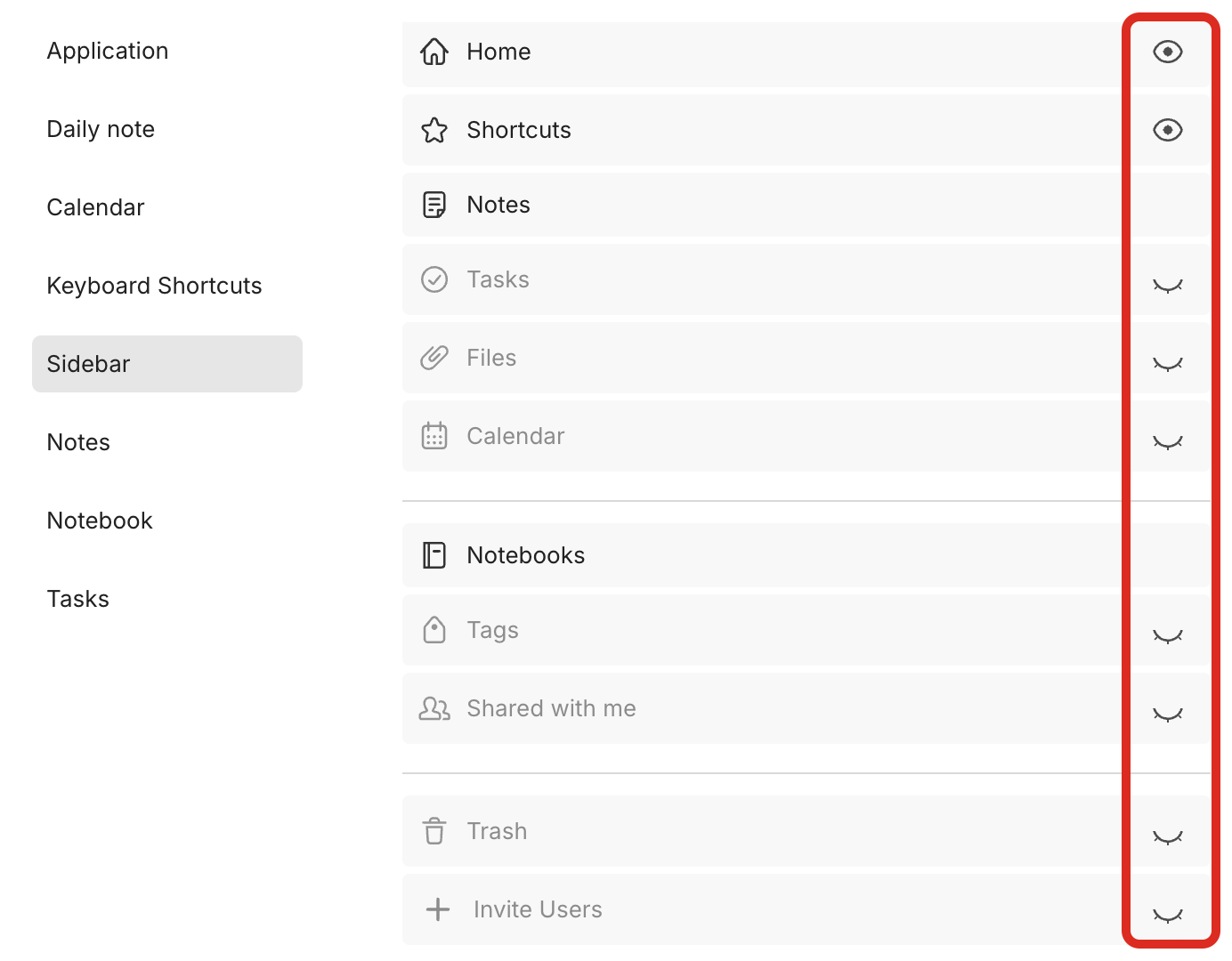
We are not done yet, but I need to take a moment to share a tip with those of you who love keyboard shortcuts.
Keyboard Shortcuts
Even if you remove, for example, Home from the side menu, you’ll still be able to use the option + command + 1 keyboard shortcut on a Mac to open Evernote Home. And that’s true for many other items. To open the Tasks page, you can use option + command + 3. The Calendar is option + command + 5.
To see all the available shortcuts (Mac or Windows), click on the keyboard icon on the lower-left side of the Evernote desktop app and go to the Navigation section.
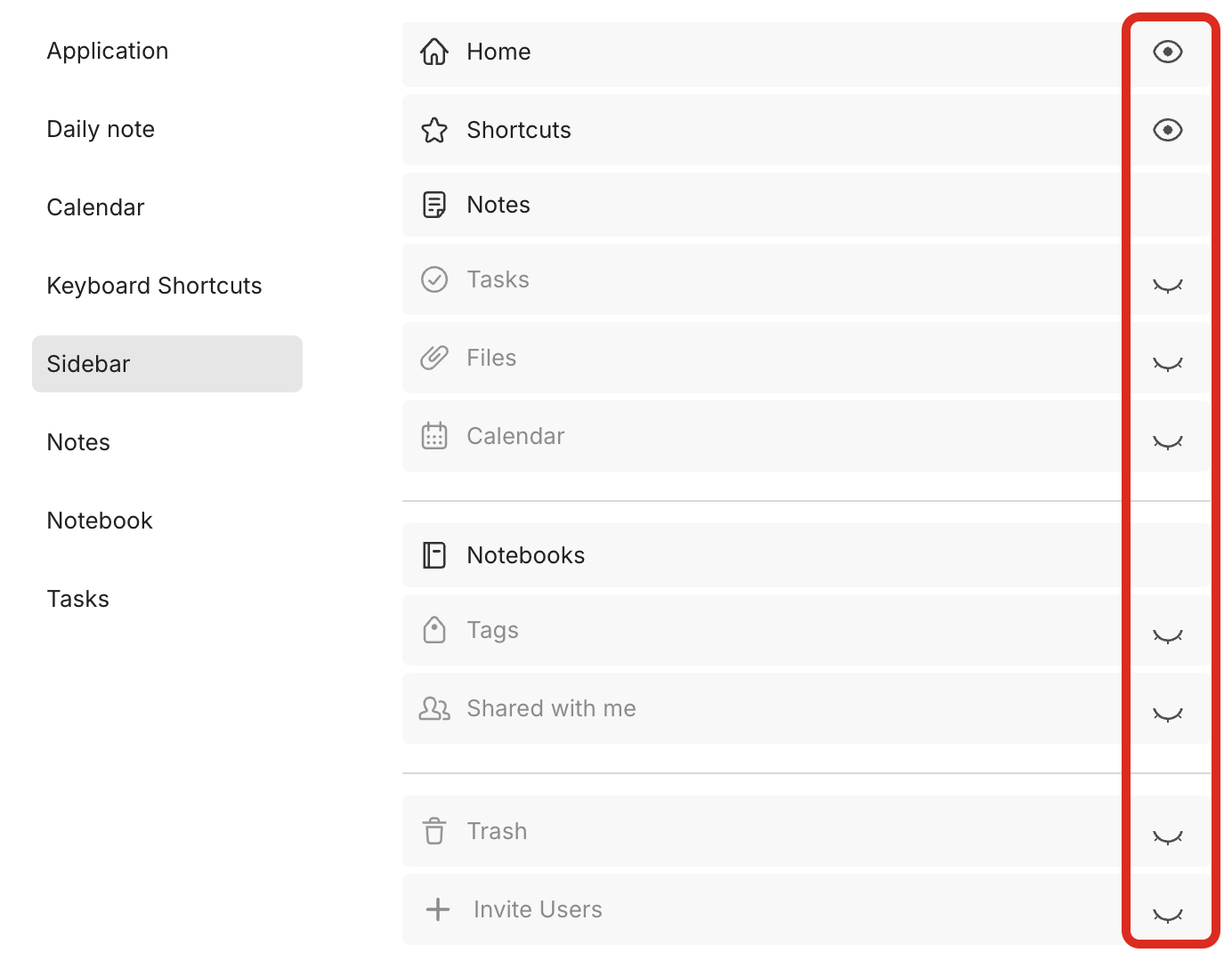
Hiding Everything
Let’s return to the top section of the Sidebar tab and discuss the Group hidden options in More. This will create a four-square icon that will provide you with access to the items you just made hidden.
I want the cleanest sidebar as possible and, in my case, I also unchecked this option. But, as everything else in this article, this is just how I’m doing things on my Evernote. There are many combinations that you can and should explore to find what’s the best for you.
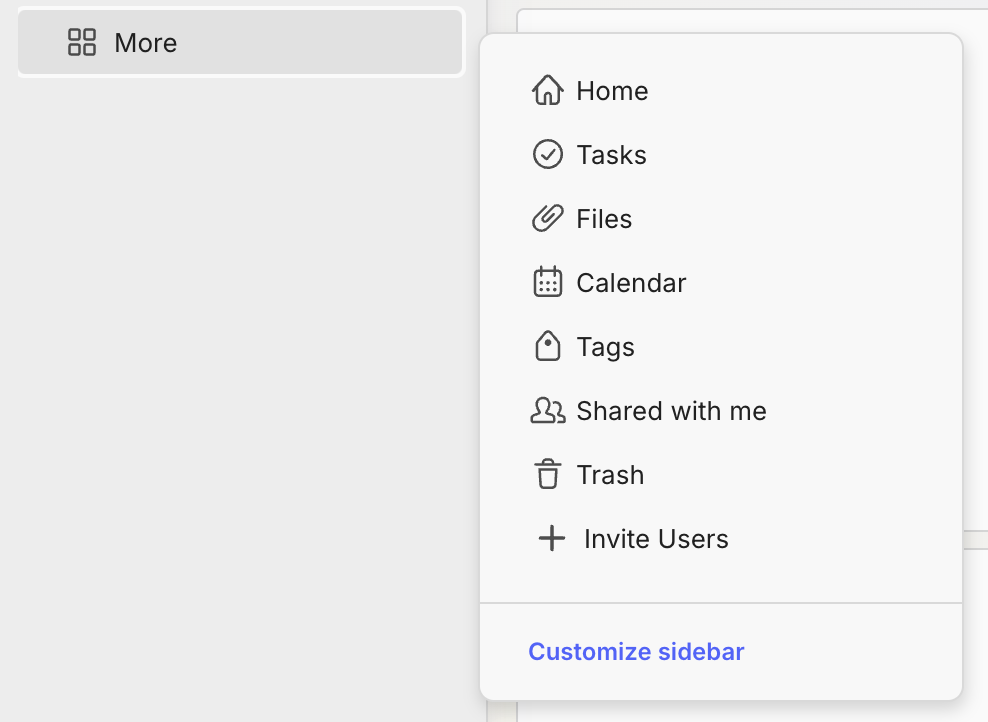
Only Notes
We are almost there. If note-taking is your focus, go to the Application tab, and select Start on Notes under the When opening Evernote section. This will open Evernote on your notes list as it used to be before Evernote 10 was introduced.
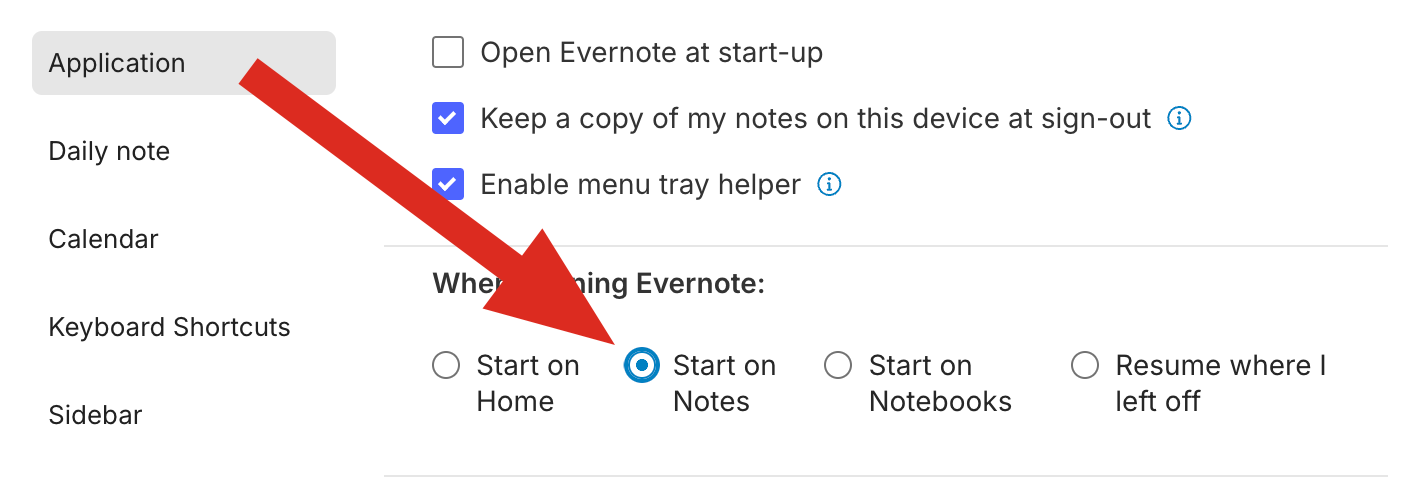
Congratulations! Your Evernote is back as a note-taking app now. But if you need it, there’s always a calendar and list of tasks a click away on Home. To learn how I set up a minimal Evernote Home, you can watch this other video.
Express Your Love
Now, if you truly love Evernote and take many notes every day, why not automatically open the app when you turn on your computer? Since you are already on the Application tab, check the Open Evernote at start-up option. That’s how you show your true love 💚
Have Fun 😆
Finally, go watch the video below to make fun of me trying to find the Show Task and Event Creation buttons option.
Bending Spoons has a vision for Evernote
As a longtime Evernote user and frequent collaborator with the team, I’ve always felt a deep connection to the app. But a recent Vergecast episode with David Pierce and Federico Simionato made me see things from a different perspective.
However, before that, “The Great Evernote Reboot” episode title evoked a wave of nostalgia. It made me remember all the years I went to the Evernote Conferences and when the company and its products were on the news all the time. Ironically, that nostalgia made me freeze for a moment and skip that episode. I wanted to listen to it with attention and give it the deserved respect and treatment. In honesty, it felt like a special moment.
The features discussed didn’t surprise me, though. For example, I just published a video about the sidebar customization. But Pierce’s approach was like turning things around just enough to give me a new perspective on Evernote’s direction after the Bending Spoons acquisition.
The goal is not to give users all the features they’ve been asking for quite some time. That’s great, but the main goal seams to be re-examining many things, from what Evernote is about for its users to the company’s revenue model. It is about focus and making the company sustainable for years to come. In a way, it feels like a reboot of the “100-year start-up” mantra, and I love it.
But listening to this episode also taught me a valuable lesson: sometimes, all it takes is a well-crafted question to gain a fresh perspective, even on something as familiar as Evernote.
Tidying up my mess is inspiring me to create delightful memories on Obsidian
One important element of my [[vladcampos.com/Static/Timeline System|Timeline System]] is what I call the Containers of Information, which can be created using any grouping feature, even tags. However, I typically opt for folders, such as in the case of Obsidian and Supernote, or Notebooks, when utilizing the system on Evernote.
One of the Containers is the Timeline, which may initially appear to be an archive, but in reality it is a dynamic part of the system that also serves as a temporary storage space.
The others, known as Action Containers, are where I keep notes about activities in progress. When an activity is completed, the note is moved to the Timeline. But since information kept there, may need to be accessed or used again in the future, it has to be easy to find.
Since there is a book explaining the system coming soon, I am not going into further details about it in this post. I just wanted to give you a brief overview of how I use the Containers to convey a sense of doing or being done. My goal today is to tell you what the videos “Preparing Obsidian to Set Up My Timeline System” are about.
Preparing Obsidian for the Timeline System
When I start using a new device or app, I often don’t spend much time organizing things. My main focus is to learn how the information I’m saving there can benefit from some of the features I’m still figuring out how to use.
However, one thing I usually do is set up Containers, as they provide a dedicated space to intuitively save all the notes and files related to a specific ongoing topic. And that’s what I did when I started using Obsidian.
When the moment came to implement my Timeline System, I had to first figure out a categorization scheme that would allow me to find all information moved to the Timeline Container. I’m not 100% there yet, but it’s already good enough, and I started moving several notes, as shown in yesterday’s video. In other words, I’m currently tidying up the mess I left behind.
As I said in the video, I am now focusing on the Trips folder. But before I talk about that, here’s how I first organized my trips on Obsidian.
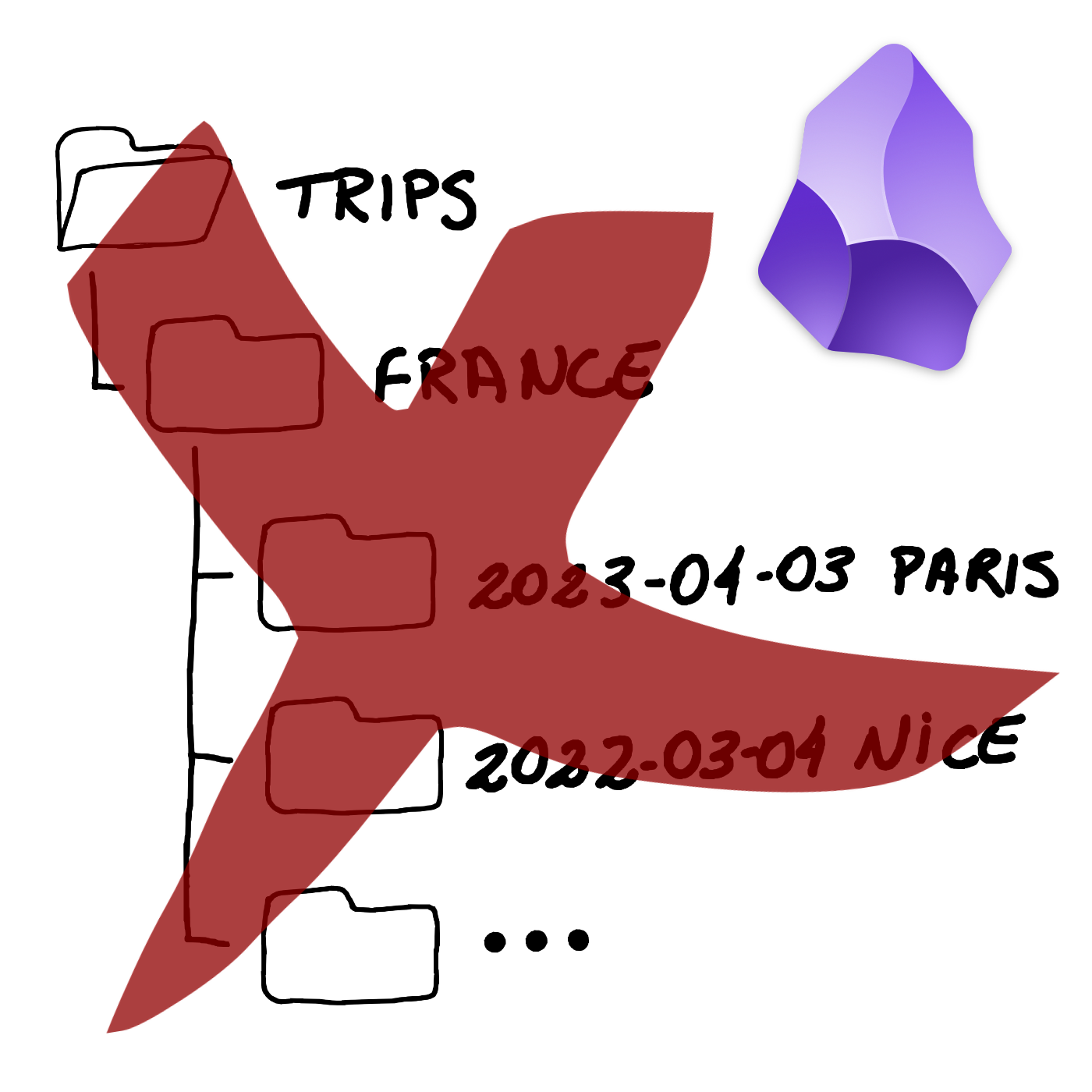
As you can see, I created a hierarchy of folders, which, by the way, is something I really don’t like. But it’s quick, and it gets the job done.
My goal now is to dismantle all that by moving PDFs and other files to the Files folder, explained in the first video of this series. Regarding the Itinerary note, which contains all the trip information and links to the files, it will be moved to the Timeline.
However, the first step is to date everything, including YYYY-MM-DD in each note’s title. I also explained the reason for this in that first video:
The Itinerary note also has the word “Itinerary” in the “type” property, and all the tags and geolocation coordinates to make it appear in the Map View plugin. By the way, I’m very excited about how cool that map will be when all of my relevant memories become a dot there.
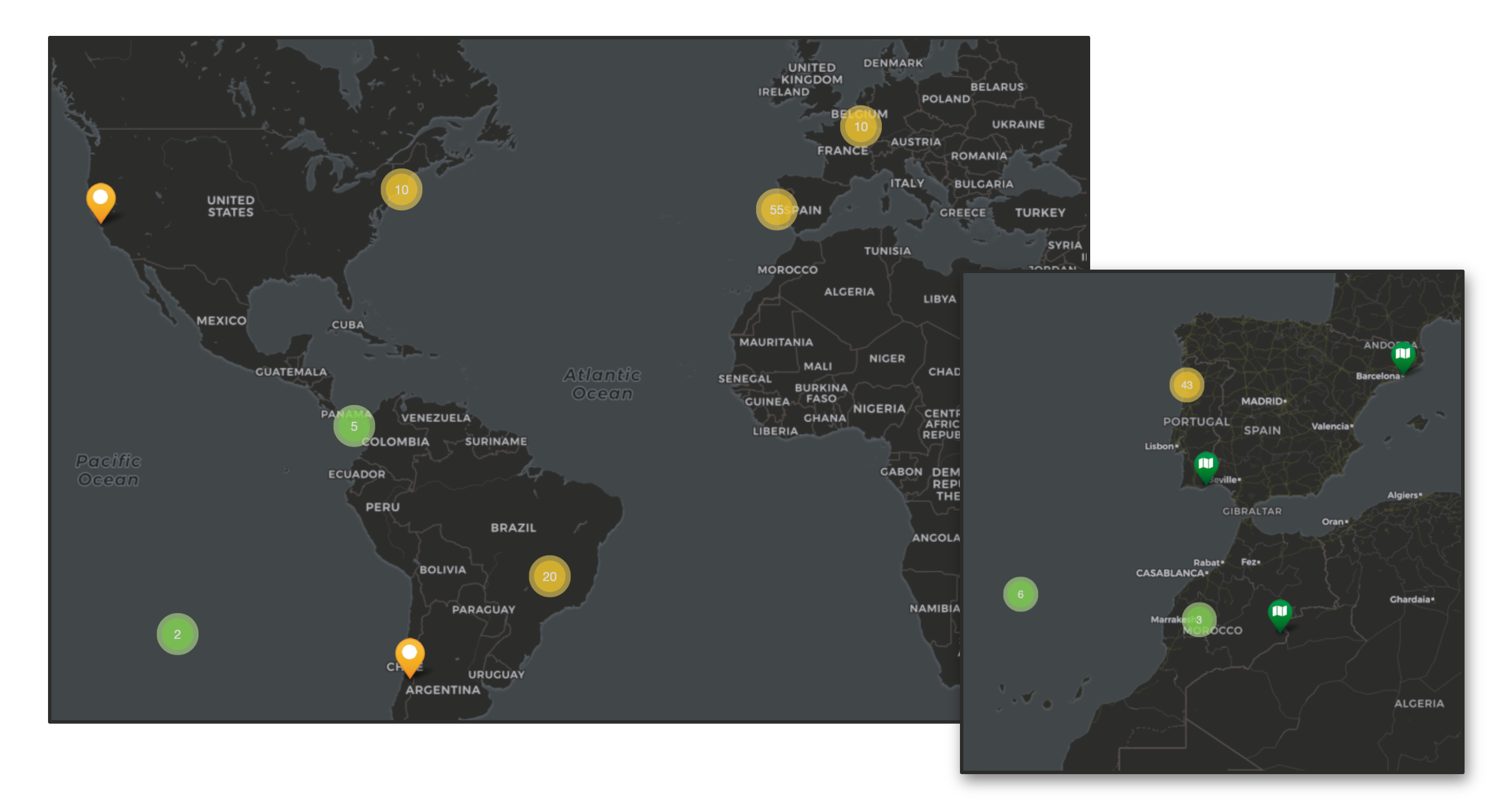
With all that done, I can start removing all files from the Trips folder, leaving only my next trips there. In other words, it will be converted into an Action Container. Meaning that whatever is inside is in progress. The final touch was to create the search below and save it as a bookmark to easily filter all my old Itinerary notes.
[type:Itinerary]
To learn how to create a search like the one above and to better visualize all the explanations in this article, please watch the video below.
Before I go, there’s actually one more thing. Remember my Photos folder? I came up with the idea of using it to save some precious photos from each trip and drag them to the correct position in the Itinerary note. And the same works for blog posts. I’m also dragging the ones I wrote while on a trip, creating this captivating snapshot of the entire journey.
And it doesn’t stop there. Anything in the Timeline related to the trip is also being added to the Itinerary notes, creating a mini journal inside a larger journal: the Timeline. I’m so overjoyed with it that I’ll definitely produce a video to show you how it works and how to build something like this.
My client didn’t show up, so let’s use that time to record another video. This one is about Evernote, as I really want to discuss a recent tweet from Federico.
On how am I rediscovering my creative freedom with digital scribbling.
The Supernote is helping me to rediscover the joy of handwriting my scripts. It’s like using magical paper to seamlessly capture and reorganize ideas.
Years before Evernote, I would write many of my first podcast scripts on any piece of paper I could get my hands on. I’d usually have the ideas during of after jogging, and it still happens today for the YouTube videos. But even though writing them down was a great way to remember later, trust me, the final “document” was typically a big mess.
Let’s be honest, it’s tough to keep handwritten notes as organized as a bullet list. Ideas don’t always flow in a neat, linear way, so it can be a real challenge to make sense of them later. My drafts were often ugly and pretty challenging to understand because of all the small text inserts. On some occasions, I would use arrows and even a second piece of paper with numbers on both parts of a sentence to try to connect them. I suppose you can imagine that it was often difficult to decipher.
In hindsight, I’d say I’d moved to digital writing as soon as technology was portable enough, probably because of the impossibility of inserting new text in between lines on paper. When I finally started using a Palm, I wrote down so many notes on it that I became an expert at using the Graffiti alphabet.
Today, I frequently write on my computer; however, typing comes with its limitations. For example, sketching can be difficult to integrate with typed text. That’s great on paper, but again, there are all the problems mentioned above. Furthermore, I’m not good at drawing, so I frequently have to erase and fix things as I go.
For example, the thumbnail you see in the image below was created at a much larger size. It was the first thing I did on that page. When I was happy with it, I resized it to fit the corner of the screen (paper?). All the text you don’t see — more on that in a moment — was rearranged several times as I was writing, just like the pieces of a puzzle slowly falling into place.
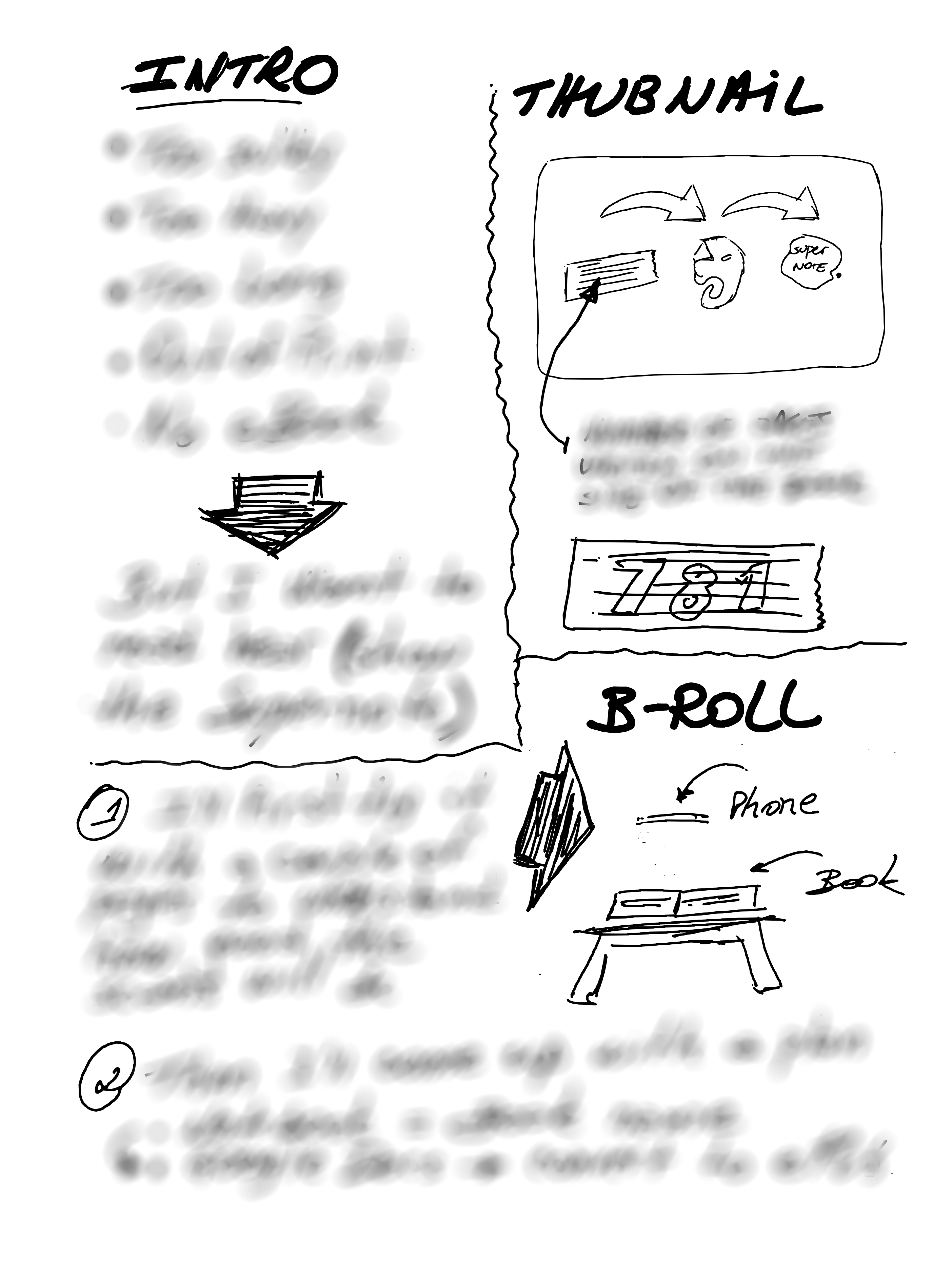
It’s impossible to do that on paper, but the Supernote brought back the freedom and joy I remember having many years ago, and improved the process. It is like having the best of both worlds. And the most convenient part is that I can easily send the final version to Evernote or Obsidian.
As for the hidden text, there’s no secret there. I’m just trying to keep a mystery aura because I have already started to produce this video and don’t want to spoil the surprise. But if you cannot contain yourself, the untouched drawing is available for supporters on Patreon and YouTube.
Anyway, I think that you can probably tell by the thumbnail and the other drawing that the video has something to do with sending content to the Supernote via Evernote.
